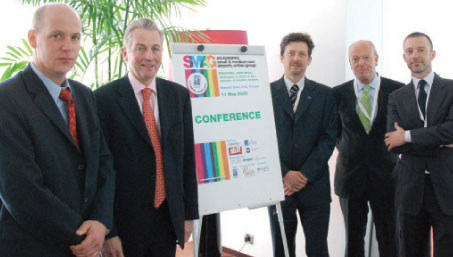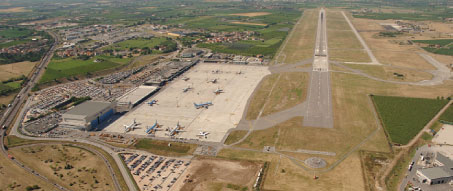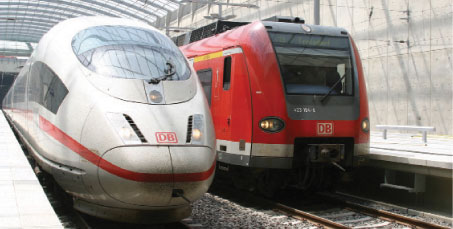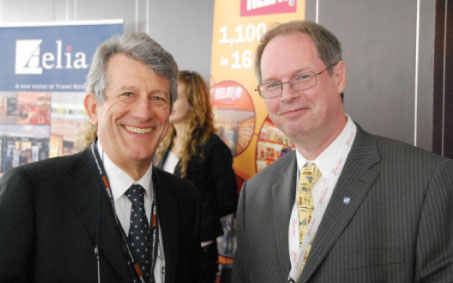 The conference was attended by some 100 delegates and as a reflection of its commitment to SMAG, ACI EUROPE was heavily represented with the majority of key staff in attendance, including Director General Olivier Jankovec, Director of Policy Morgan Foulkes, General Counsel Gerard Borel, Senior Policy Manager Stefano Baronci, Policy Analyst Vanessa Holve, Membership Services Manager Danielle Michel and Communications Manager Robert O’Meara.
The conference was attended by some 100 delegates and as a reflection of its commitment to SMAG, ACI EUROPE was heavily represented with the majority of key staff in attendance, including Director General Olivier Jankovec, Director of Policy Morgan Foulkes, General Counsel Gerard Borel, Senior Policy Manager Stefano Baronci, Policy Analyst Vanessa Holve, Membership Services Manager Danielle Michel and Communications Manager Robert O’Meara.

Left to right: Gernot Kessler, Paul Whelan, Giuseppe Rizzo, Olle Sundin and Olivier Jankovec.
The day opened with words of welcome from Alex Kirby, followed by Olivier Jankovec and Paul Whelan (Chairman of SMAG and CEO of the Low Cost Airport Group). Jankovec and Whelan made clear the extraordinary growth in SMAG airports: there are presently over 130 airports participating in SMAG, in 45 countries across Europe. The highest percentages in traffic growth clearly come from SMAG member airports, in the ACI EUROPE monthly traffic reports. The key role that such airports play in regional mobility across the EU and beyond should not be underestimated. Jankovec also pointed out some of ACI EUROPE’s policy activities for SMAG, citing their partnership with the EU Committee of the Regions and their securing of key amendments to the EU Directive on airport charges in order to exclude regional airports from its scope. He also mentioned ACI EUROPE’s recent partnership with anna.aero to launch The Route Shop, an online route development store for airports seeking airlines.
The keynote address was given by Claudio Boccardo, General Manager of Verona Airport Systems, long-time SMAG member and FARE Executive Board member. Citing the case of Verona and Brescia airports, he gave details of the business focus of these two airports, their structure, traffic mix and their main sources of growth (eg. cargo). He also expanded on a €170m investment plan, which includes improving surface access to the airports.
Mehrdad Noorani from Global Infrastructure Partners afforded the audience a rare opportunity to hear a venture capitalist’s perspective on airport investment, as well as an informative review of GIP’s extraordinary purchase of London City airport and their strategy for its expansion. The traffic increase that GIP currently forecasts for London City is for a passenger throughput of eight million passengers by 2030.

Claudio Boccardo, General Manager of Verona Airport Systems and Member of the FARE Executive Board, expanded on a €170m investment plan for Verona and Brescia airports, which includes improving surface access.
MORNING SESSION: EU regulatory impact on regional airports
This session was chaired by Gerard Borel of ACI EUROPE. Neil Pakey, Managing Director of Liverpool John Lennon Airport and recent Chairman of AOA, spoke about airport charges. Highlighting the 743% growth at Liverpool John Lennon since 1997, his presentation went on to talk about the potential impact that the new airport charges directive might have in regional airport’s development and the ultimate effect on the consumer.
Audrey Gil from Aeroporto Cagliari spoke passionately on the market power of regional airports, underlining the need to focus on what passengers want and the route development methods which Cagliari has found most effective.
Commission’s Contribution
The European Commission was represented by two speakers: Giuseppe Rizzo, Administrator of Airport Policy and Gernot Kessler, Administrator of Aviation Safety, both from DG TREN.
Rizzo gave a presentation on the funding available for TEN-T (Trans-European Transport Network) and intermodal solutions, mentioning the 83 airport projects (totalling €140m) funded by TEN-T in the past 12 years. The latest supported projects announced include Katowice (€0.81m), Manchester (€1.64m) and Milan Malpensa (€1.71m).
Kessler’s presentation was entitled ‘EU regulation – opportunity or threat for regional airports?’ and emphasised the important part that the second Single European Sky package (SES2) will play in underlining the significance of regional airports in the grand scheme of European mobility. He also went into some detail on the security and safety aspects.

Giuseppe Rizzo, Administrator of Airport Policy, European Commission, gave a presentation on the funding available for TEN-T (Trans-European Transport Network) and intermodal solutions, mentioning the 83 airport projects (totalling €140m) funded by TEN-T in the past 12 years.
AFTERNOON SESSION: Partnerships – the keys to growth
Olle Sundin, Vice-Chairman of SMAG and Managing Director of Regional Airports at LFV opened the second session, outlining the case study of Kiruna Airport as an example of LFV’s dynamic and innovative approach to regional airports.
Dr Ossian Stiernstedt, Senior Director of Business Development for the Göteborg Region was the second speaker and his presentation proposed that tourism is the primary key to the successful development of a region, wherein the airport has a vital role to play.
Richard Schano, Director of International Affairs at Salzburg Airport, also well-known to SMAG members, commanded the audience’s attention with a stirring presentation on airport marketing. Dividing the various airlines into their respective categories, he detailed the number of charter flights, legacy carrier and LCCs that currently form an impressive traffic mix, which has boosted Salzburg Airport’s performance in recent years. His presentation also reiterated the need to know the profile of your passengers, as well as stressing the opportunity that smaller airports have to gain market share, given their spare capacity and low costs.
Next, it was the turn of Jacques Sabourin, Delegue General of UAF who detailed the extraordinary rise of numerous regional airports in France, in the past 10 years, including examples such as Carcasonne, Biarritz and Bergerac.

Claudio Boccardo (Verona Airport Systems) and Richard Schano (Salzburg Airport).
Debate
The second afternoon session comprised a debate on the relationship between airports and airlines. John Strickland of JLS Consulting chaired the debate, while panellists included Janis Balkens (Riga Airport), Tonci Peovic (Dubrovnik Airport), Olivier De Marmol (Liege Airport), Daniel Långsten, (Wings of Europe) and John Grant (ASM). The panel for this session was wide and varied, as was the debate, weaving as it did between different aspects of the airport-airline relationship such as the role of regulation, the question of subsidy, unbundling of airport services, the pros and cons of low cost terminals, the individual challenges facing each side, and the difficulties that are mutually understood in the current economic climate.
On the matter of the seasonality of many regional airports’ business, Peovic asserted that flexibility and multi-tasking of the airport personnel could play a vital role in rendering the airport more efficient.
The topic of the airline-airport relationship – Langsten countered the claim that today’s airlines are ‘airport-shopping’, by stating that Wings of Europe considers long term potential a key element in the routes it considers. Whelan asserted that airports must become more creative in their revenue-streams.
The question of EU regulation yielded some polarised opinions, with Grant lamenting the overregulation and complexity that has increased costs, while Balkens asserted that there is abuse of regulation and Peovic cited the positive results that liberalisation has afforded the European aviation market.
The conference finished with Paul Whelan presenting the conclusions of the day, followed by a brief audio-visual taster of Linz Airport, which will be hosting next year’s SMAG conference – which is scheduled to take place on 2-4 March 2009.







